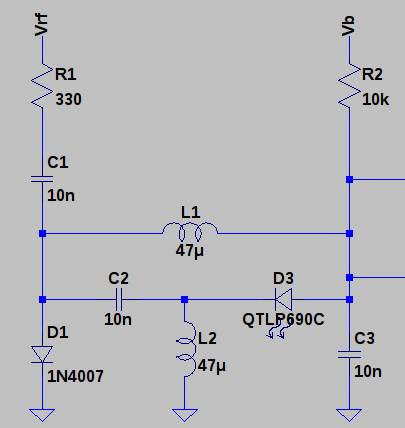I was reading about the #One Transistor Latch project and it reminded me that I came up with a two diode latch at one point. Here's the idea (note that the diodes are labeled D1 and D3, even though there are only two of them):

Like the DDL logic gates, it uses both RF and DC bias power supplies. D1, a 1N4007 rectifier, is used as a PIN switch, while D3, an LED, serves as a rectifier and state indicator.
In the "0" state, DC bias current flows through R2 and L1 to bias D1 into a conducting state. As in a PIN diode, this forward bias makes the diode present a low impedance for RF current, so RF current through R1 and C1 is shunted to ground through D1.
If we momentarily disconnect the DC bias supply, Vb, D1 stops conducting, and begins to show a high impedance at RF. Now, RF energy flows through R1, C1, and C2, to become rectified by D3, charging C3 to a negative voltage. This negative voltage reverse-biases D1, maintaining its high impedance at RF. Even if we now reconnect the DC bias supply, the rectified current is enough to offset the bias through R2, so the "1" state is maintained. While D3 is rectifying current, it emits a nice glow to indicate the "1" state.
You could also set the state with some switches that temporarily shorted R1 or R2 to ground. This might make for an interesting demo circuit. In simulation, I chose to use two more diodes to switch the state. Here, D4 and D5 alternately switch the latch state based on their respective pulse generators:

Here, you can see how the pulses set the latch state:

The top trace (magenta) sets the "1" state with a low-going pulse through D4. This causes D3 to start rectifying current, shown in yellow. This state continues until a positive-going pulse through D5 flips the state so that D1 starts conducting again, which stops current through the LED.
Is it practical? Probably not. But I think it's pretty interesting that you can store a bit of information in two diodes and a handful of passives.
 Ted Yapo
Ted Yapo
Discussions
Become a Hackaday.io Member
Create an account to leave a comment. Already have an account? Log In.
nice!
Are you sure? yes | no